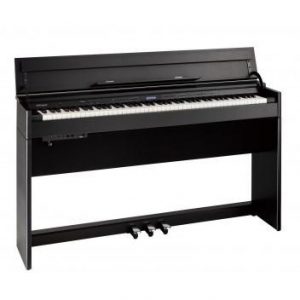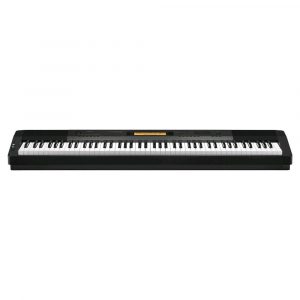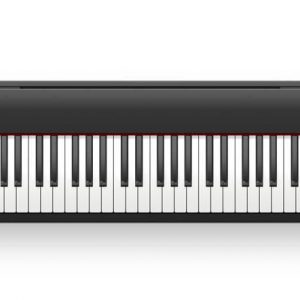Korg LP-380
$541.99
The Korg LP-380 piano offers a rich and authentic sound, combined with an elegant design that complements any home décor.
Compare
Description
The Korg LP-380 digital piano is a product of Japanese electronic instrument manufacturer Korg Inc. It is a compact and stylish instrument designed to deliver a high-quality piano sound and feel.
The LP-380 features a beautifully crafted cabinet that comes in three different finishes; black, white or rosewood. The piano boasts an RH3 real weighted hammer action keyboard, which replicates the natural touch and feel of a grand piano. The keys are also sensitive to the touch, which means when played softly or loudly, the sound is adjusted accordingly.
The LP-380 comes with a high-quality sound engine and a wide range of expressive sound options. The piano features 30 different sounds ranging from acoustic pianos to electric pianos, organs, and strings. The sound system incorporates a stereo amplifier and two speakers that deliver an immersive sound experience, particularly when playing in a small to medium-sized room.
The LP-380 has a flexible connectivity feature, allowing it to be easily integrated with other devices, such as computers, digital recorders, or even smartphones. It has a USB port, MIDI in/out, and a headphone jack. The headphone jack allows for private practice or late-night sessions, without disturbing others.
Additionally, the LP-380 has several inbuilt features that make the playing experience more enjoyable. One of these is the layering function, which enables users to play two different tones simultaneously. This is particularly useful when playing with an ensemble or when creating more complex arrangements.
Another feature is the partner mode function that divides the keyboard into two identical sections that can be played simultaneously, making it perfect for duets or teaching purposes.
Overall, the Korg LP-380 is a great buy for anyone looking for a compact but powerful digital piano. With its elegant design, high-quality sound, and the flexibility to connect to other devices, this piano is undoubtedly one of the best in its class.
Korg LP-380 properties
| Product name |
LP-380 |
| Brand |
Korg |
| Type |
Keyboard Instruments |
| Keyboard Instrument |
Stage and Digital Piano |
| Keys |
Yes |
| Number of Keys |
88 pcs |
| Colour |
Black, Red, White, Wood |
Frequently Asked Questions:
How does the Korg LP-380 digital piano's RH3 (Real Weighted Hammer Action 3) keyboard technology provide a more authentic and responsive touch for both pianists and composers?
The Korg LP-380 digital piano features Korg's patented RH3 (Real Weighted Hammer Action 3) keyboard technology, which provides a more authentic and responsive touch compared to other digital pianos. This technology is designed to simulate the behavior of an acoustic grand piano, making it feel more natural and intuitive for both pianists and composers. The RH3 keyboard uses a graded hammer action, which means that the keys are weighted differently depending on their location on the keyboard. This allows for a greater range of expression and dynamics in your playing, as you can apply more pressure to the lower register keys to produce deeper, richer tones, while using lighter touch on the higher register keys for more delicate sounds. Another key feature of RH3 technology is the use of real wood keys, which provide a more natural feel and response compared to synthetic materials. The white keys are made from ivory-feel material, which offers a comfortable grip even during extended playing sessions, while the black keys are made from synthetic ebony. Overall, the RH3 keyboard on the Korg LP-380 digital piano provides a more authentic and responsive touch that closely replicates the feel of playing an acoustic grand piano. Whether you're a seasoned pianist or just starting out, this technology will help you develop your skills and express yourself with greater nuance and finesse.
How does the Korg LP-380's RH3 (Real Weighted Hammers) keybed provide a realistic piano touch and response?
The Korg LP-380's RH3 (Real Weighted Hammers) keybed replicates the weight and action of an acoustic piano keys, providing a realistic and responsive touch. The RH3 mechanism utilizes actual wooden keys with graded weights, allowing for a natural and accurate response to the user's touch. Additionally, the keys offer a satisfying resistance and feedback, simulating the feel of playing on a grand piano. This technology ensures that users can enjoy a truly authentic and immersive piano experience.
How does Korg's RH3 (Real Weighted Hammers) keyboard action on the LP-380 accurately simulate the characteristics of an acoustic piano?
Korg's RH3 (Real Weighted Hammers) keyboard action on the LP-380 accurately simulates the characteristics of an acoustic piano by utilizing a new system that calculates the optimal balance between playability and natural response. This system allows for a gradual touch curve, which is lighter at the high end and heavier in the low end, just like the keys of a grand piano. Additionally, the RH3 action features counter weights in the keyboard assembly to add weight to the bass end, as well as letting the hammers see a longer key throw for a more natural feel when playing fortissimo passages. The RH3 action also has an escapement mechanism that reproduces the feeling of a grand piano as the keys return after being played, providing a more realistic and authentic playing experience. Overall, these features work together to accurately simulate the characteristics of an acoustic piano, allowing for a highly expressive and satisfying playing experience on the LP-380 digital piano.
How does the Real Weighted Keyboard technology of the Korg LP-380 contribute to a more authentic piano playing experience?
The Real Weighted Keyboard technology of the Korg LP-380 plays a significant role in providing a more authentic piano playing experience. This innovative feature ensures that each key on the keyboard is weighted differently, simulating the touch and response of keys found on a grand piano. The higher notes are lighter, while the lower notes require more force to be pressed down, just like on an acoustic piano. This realistic feel enables pianists to play with greater expression and nuance, making their performances more dynamic and authentic. Overall, the Real Weighted Keyboard technology enhances the playing experience, allowing musicians to fully immerse themselves in their music and achieve a higher level of performance.
What is the optimal settings for the built-in reverb on the Korg LP-380 to achieve a balanced sound when playing the digital piano's grand piano voice?
1. Hall Type**: For a grand piano sound, I recommend using the "Large Hall" setting. This will give you a balanced and spacious sound that complements the grand piano voice. Room Size**: Adjusting this parameter can affect how much of the original sound is retained versus the reflected sound. If your music sounds too distant, try reducing the room size. For a more natural sound, set it around 50-60%. Damping Ratio**: This controls how quickly the reflections decay. A higher damping ratio will make the reverb sound shorter and more focused. I suggest keeping this around 20-30% for a grand piano sound. Level**: Adjusting the level of the reverb can help balance it with your sound. If you find that the reverb is overpowering, reduce its level. For a more subtle effect, increase it slightly. Reflections**: This setting controls how many times the reflections bounce back before they're attenuated. A higher number will give you a longer reverb time but might also make your sound sound muddier if not balanced correctly. Experiment with this to find the right balance for your music. Decay Time**: This determines how long it takes for the reverb to fade away completely. For a grand piano, a decay time of 2-3 seconds is usually sufficient but can vary depending on your preference. To achieve an optimal setting:
- Start with the "Large Hall" type and adjust the room size until you find a balance that works well with your music. Experiment with different damping ratios to find one that complements the grand piano voice. Adjust the level of the reverb so it's just noticeable but not overpowering. Play around with reflections to achieve the right balance between ambiance and clarity. Finally, adjust the decay time based on your preference for how long you want the reverb to last. Remember, these are general guidelines. The best setting will depend on your personal taste and the specific music you're playing. Experiment with different settings until you find one that complements your sound perfectly.
What are the key differences between the Korg LP-380's RH3 weighted action and a traditional acoustic piano's action, particularly in terms of touch sensitivity and dynamic range?
1. Weighted Hammers vs. Strings**: The most obvious difference is that an acoustic piano uses strings and hammers, whereas the LP-380 uses weighted hammers (or keys) with built-in sensors. These hammers are designed to mimic the feel of a traditional hammer striking a string, but they don't actually strike anything. Touch Sensitivity**: Both systems have excellent touch sensitivity, allowing for nuanced dynamic control. However, some players report that the RH3 action can be slightly more resistant at the lower end of the range (i. In contrast, acoustic pianos tend to feel more natural and fluid in terms of touch sensitivity. Dynamic Range**: The dynamic range of an acoustic piano is virtually unlimited, as it can produce both incredibly loud and soft sounds with ease. Digital pianos like the Korg LP-380 also have a wide dynamic range, but it's capped at around 120 dB (decibels). While this is still plenty for most musical applications, some players may notice a slight loss of dynamics at the very extremes (i. Key Repeat and Hammer Strike**: The RH3 action has a more subtle key repeat compared to traditional acoustic pianos. This means that when you hold down a key, it will gradually build up in volume rather than suddenly jumping to the next level of intensity. Acoustic pianos tend to have a slightly more pronounced key repeat, which some players prefer for certain musical styles. Hammer Strike and Release**: In an acoustic piano, each hammer strike has a unique sonic signature due to factors like string tension, hammer material, and the angle at which they strike the strings. The RH3 action attempts to replicate this with its weighted hammers, but it's difficult to perfectly capture the nuances of an acoustic piano's sound production. In summary, while the Korg LP-380's RH3 weighted action is a significant improvement over earlier digital pianos, there are still some differences between it and a traditional acoustic piano. These differences can be subtle, but they may affect the overall playing experience for some musicians.
Before you buy Korg LP-380






Reviews
There are no reviews yet.